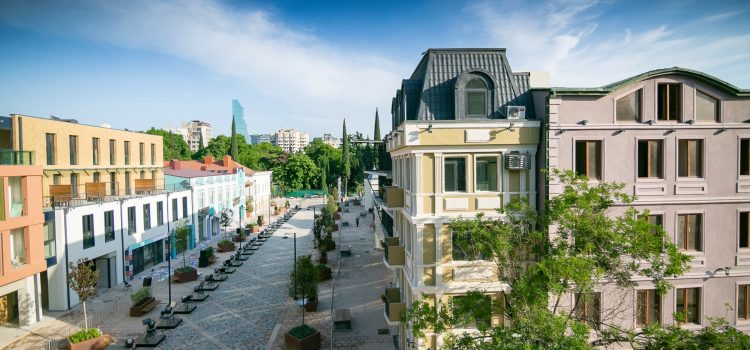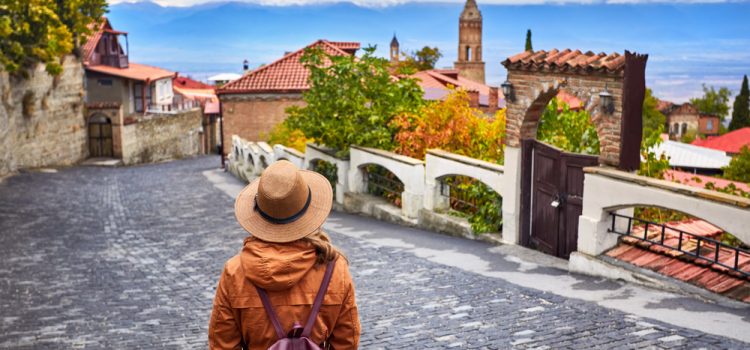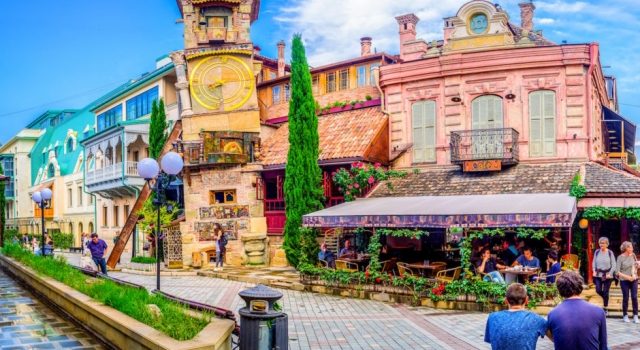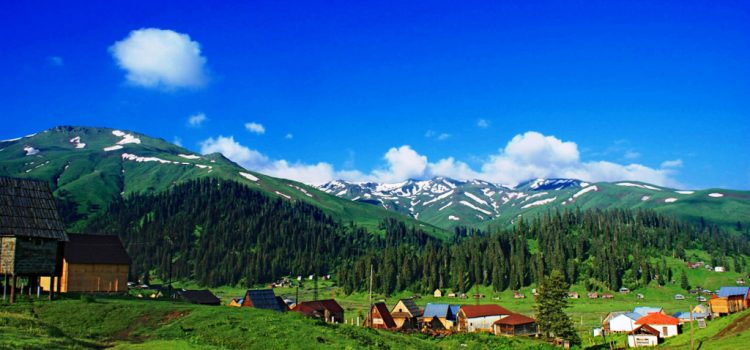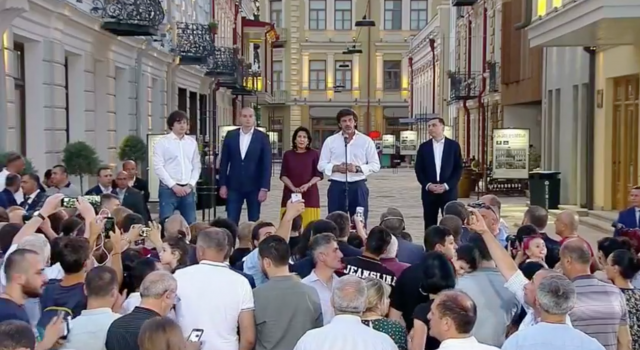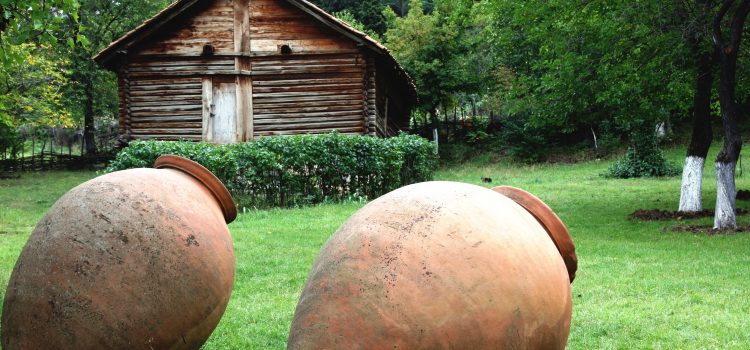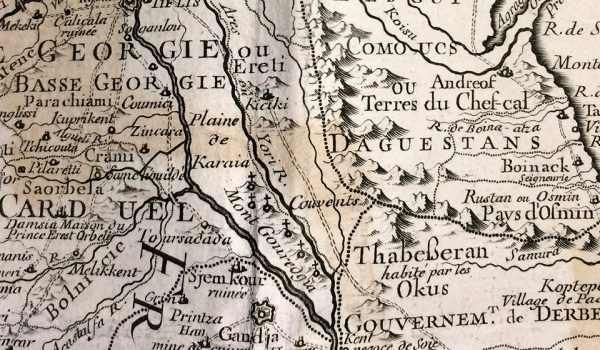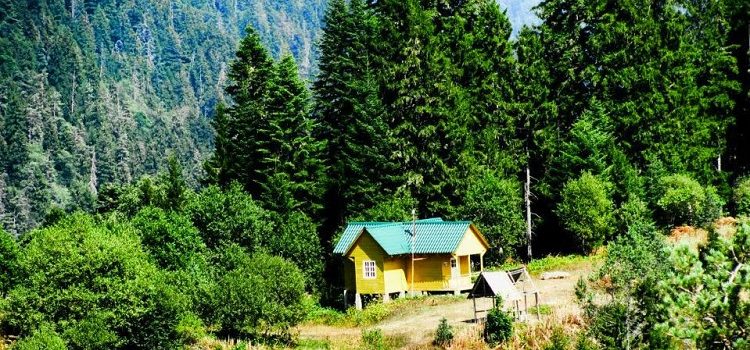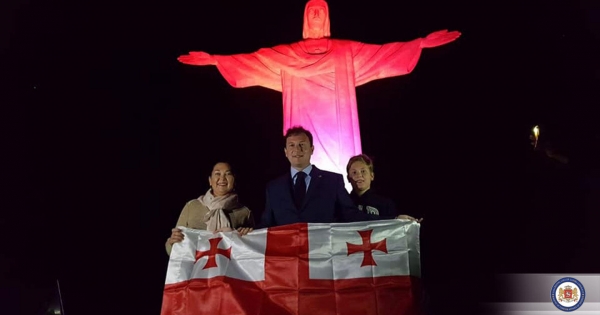Tbilisi Mayor: “Orbeliani Square to be one of Tbilisi’s most beautiful areas”
“Orbeliani Square will be one of Tbilisi’s most beautiful areas”, promises Mayor of Georgia’s capital Kakha Kaladze, who visited the construction site today to inspect how the rehabilitation works are undergoing.
Currently, two buildings are being dismantled on Orbeliani Square, where later a new one will be built.
Meanwhile, construction rehabilitation has finished on Mtkvari and Virsaladze streets where underground communications were arranged and also a new cover of asphalt was laid.
The rapid and major transformation of Orbeliani Square started in December of last year. This is the second state of the New Tiflis project, which launched in 2016 when the Government of Georgia renovated 45 addresses on Aghmashenebeli Avenue in the Marjanishvili neighborhood.
This time, the rehabilitation site covers Atoneli, Virsaladze, Pkhovi, Treasury, Bridge, Purtseladze and Tabukashvili Streets, where the rehabilitation of underground engineering communications’ systems is underway. In total 18 buildings will be rehabilitated of which 13 are historical buildings.
The first stage of the project includes the renewal of drainage, wastewater, sewage and water supply systems as well as the refurbishment of gas and electric supply systems.
The next stage of the project includes the restoration-rehabilitation of buildings and the construction of an underground parking lot, which will commence after all underground engineering communications’ systems will have been rehabilitated.
The rehabilitation of Grigol Orbeliani Square and its adjacent areas will cost about 55 million GEL in total and is due to be finished by the end of 2018.
source: www.agenda.ge
Georgia’s Historic Gem: Sighnaghi, The City of Love
Sighnaghi is a charming little town to the east of Tbilisi, located at an altitude of 740 meters above sea level. The town offers scenic views of the Alazani Valley and the Great Caucasian ridge, but not only this: Sighnaghi and its surroundings are being developed rapidly with more and more attractions popping up by the year.
When I first went to Sighnaghi in 2010, the town was already in the process of being restored. But even back then, a visit to Sighnaghi was a great experience in itself, taking into account its great historic wall, Sighnaghi National Museum, which houses a number of great masterpieces of Niko Pirosmani, and the town’s location close to the famous pilgrims’ destination, the Bodbe Monastery.
In 2010, Sighnaghi, in terms of infrastructure, didn’t have much to offer visitors aside from its great panoramic views and a few newly refurbished central streets. It had a few restaurants, one hotel and a couple of guesthouses. The rest of the town, with its crumbling facades, rusty roofs and pot-holed roads, reminded one heavily of a Potemkin village.
Since then, many things have changed. The city’s appearance, its roads, facades, and infrastructure have been restored or renovated; and throughout the town numerous restaurants and guesthouses have been established. Tourists from all over the world, including China, South Korea and Japan, now stream to Sighnaghi, meaning you’ll be hard put to find a household there which is not somehow involved in the tourism business.
“When I registered my guesthouse in the Booking.com system three years ago, I was the 34th on the list of Sighnaghi accomodation,” said Roman Beghashvili, a Sighnaghi guesthouse owner. “Now, there are around 150 on the list.”
Competition drives those in tourism to make their places more attractive to tourists. The ideas vary and are sometimes rather eccentric. There are plenty of picturesque cafés and hotels built beside the historic Sighnaghi wall. One of them, for instance, located on high stilts, seems to be hovering over the town, and offers guests the chance to take a paraglider flight or enjoy a drink overlooking the Alazani Valley and the historic wall, which is more than 4 km long. I’ve only had one comparable view of a medieval wall, and that was in the historic city of Avila in Spain.
“The first reminiscences of our town wall were found in chronicles of the 13th century,” said Mariam Guliashvili, the town historian. “But the construction of the wall which you can see now was ordered in the 18th century by King Irakli II. Our enemies used to attack our villages in the Alazani Valley: from the north came the Lezgins, from the south the Persians. They stole our women, children and livestock in order to sell them into slavery. To protect the inhabitants of the valley from the intruders, King Irakli II gave the order to construct this wall, which according to different documents was between 5 and 7 km long and had 23 towers and eight gates. Now we have over 4.5 km of it left, which comes close to the Small Wall of China with its 5 km length.”
Sighnaghi received its “city” status in 1770. At that time, it was already a vivid town of workmanship and trade with a population of up to 10,000 people, the majority being of Armenian origin. The King had ordered the Armenians to settle in Sighnaghi, as the Alazani Valley had previously been devastated by Shah Abbas, who took 100,000 Georgians to Persia.
In the following centuries, Sighnaghi became a great cultural and educational center, with its own theater and schools. Girls were educated in private schools established in the houses of rich citizens. In Soviet times, Sighnaghi was a flourishing tourist attraction with a big hotel located close to the town. The town was proud of its own Ethnographic Park, where archeologists from all over the country worked together on excavations. You still can visit this area now, if you take a walk in the beautiful and newly restored town park, which is romantically located on the slopes of Sighnaghi, behind the wall. Also worth a visit is the local cemetery, bearing many exciting stories of past times. With a little imagination, you can see the town history right there.
In order to inquire about recent tendencies in tourism, I headed to the Sighnaghi Information Center. The officer, Zurab Siprashvili, told me that just 10% of those who come to Sighnaghi actually visit the Information Center. He put the number of tourists that visited Sighnaghi last year at around 11,000 people, with the trend growing by the year. Most of the tourists come from Russia, Poland, Germany, France and Israel.
Sighnaghi’s location on a hill high above the ancient winemaking valley contributes to its increasing popularity. There are four big wineries as well as many wine degustation points in Sighnaghi.
From the town’s Deputy Mayor, Madonna Batiashvili, I learned about further plans concerning tourism and further development of the Sighnaghi region. “In future, we want our guests to stay longer in our region, so we plan to develop the nearby villages of Tsnori and Machkhaani. The latter is a unique village with an old theater from the 19th century and many historic houses, which are quite different from the usual Kakhetian houses. Machkhaani will soon be given the status of a Museum Village,” Batiashvili noted.
The town council plans to establish a new tourist route connecting Sighnaghi, Tsnori, Machkhaani and proceeding to Dedoplitskharo, a city with its own Pirosmani museum. Investments should be made in agricultural tourism for those visitors who enjoy nature, hunting and fishing, and who want to learn more about making churchkhela and baking Georgian bread. Several cable car routes should be established in order to connect some villages and allow visitors to enjoy great views of the Alazani Valley.
What else makes Sighnaghi so attractive for tourists? One of the town’s most renowned attractions is a quick marriage in the Marriage House, which operates 24/7.
“All you need is your passport and two witnesses,” Batiashvili told us. “Just imagine: I recently met a couple who became husband and wife early in the morning, at 4 am!”
Indeed, getting married is easy in Sighnaghi, as you don’t need to deal with bureaucracy at all. “Many of our citizens have become witnesses already, and they are now treated as relatives by the families of the newly married couples,” Batiashvili proudly said.
Source: www.Georgiatoday.ge; By Tatiana Montik
Matador Network: Why You Need to See Tbilisi
Matador Network has dedicated an article to the capital of Georgia, Tbilisi, giving reasons why it is a good idea to visit the city.
The article reads that Georgia is unknown to many travelers but that it is slowly becoming a hot destination. It also says that there are a lot of activities that can be done in Tbilisi.
“You can stroll in Rike Park along the Mtkvari River and watch kids play in the grass. From the park, you can take a cable car to Narikala Fortress for a sweeping view of the city. Or you can wander around in the streets of Old Town, go to the market, and eat all the food you can,” it says, adding the food is very inexpensive, and you can find good private accommodation for a few dollars a night. Moreover, traveling by taxi is also common and cheap.
Another reason named in the article as to why travelers should visit Tbilisi is that the architecture there is “quirky and awesome.”
“Influences from Europe, Persia, the Arab world, and Russia have shaped Georgia’s identity, resulting in one of the most unique cultures in the world,” the article reads, adding this combination of the future and the past will definitely leave an impression.
For people traveling with kids, the article recommends visiting Mtatsminda Park, a big amusement park at the top of Mount Mtatsminda, at over 2,500 high and the highest point in the city. It was also a very popular public park in the USSR during the Soviet Union.
The author underlines that Georgian people are very welcoming.
“Georgians are some of the warmest and most welcoming people in all of Europe. Although many of them don’t understand or speak English, they’ll go out of their way to help you out,” it says.
And of course, Georgian cuisine is one of the top reasons why one should visit the country, where “every meal is a feast.”
“Most meals in Georgia include more food than can physically fit on the table. A must-try is khinkali, Georgian dumplings,” the article reads.
In addition to this, only a two-hour drive away from Tbilisi you will find Sighnaghi, a picturesque, small town in Kakheti, the wine region of Georgia.
“Sighnaghi is a cobblestoned village and the perfect place to try some of the famous Georgian qvevri wine,” reads the article.
Source: www.Georgiatoday.ge; By Thea Morrison
Photo: www.Georgiatoday.ge
Bakhmaro – Unique resort with healing properties
Bakhmaro located in Guria (western Georgia) is one of the healthiest resorts of the country. It lies on the Bakhvistsqali River. Bakhmaro is distinguished by the combination of alpine and marine climate. It is situated 1950-2050 meters above sea level. This is the highest alpine climate resort in Georgia. The resort abounds with spruce, pine and fir trees.
All the mentioned features make Bakhmaro a magical place for many people with health problems especially those with lymph, respiratory diseases and anemia. Besides its heavenly landscape, beautiful pine forests, alpine meadows and amazing views the area are notable for its small cute cottages that are scattered throughout the green valleys with a river flowing through them.
It is believed that visiting Bakhmaro will make your immune system stronger. Its clean and transparent air speeds recovery from illness. Two centuries ago a shepherd diagnosed with tuberculosis visited the area (before the resort was discovered and named) and recovered from the disease. At that time, people thought it was a miracle but later the unique properties of the area were discovered and it was named the resort Bakhmaro.
Source: www.Georgianjournal.ge
Orbeliani Square Re-Opens After Renovations
Orbeliani Square in Tbilisi has re-opened in an opening ceremony following two years of renovations.
Georgian Prime Minister Mamuka Bakhtadze, President Salome Zurabishvili, Parliament Speaker Irakli Kobakhidze, Tbilisi Chairman Giorgi Tkemaladze and Tbilisi Mayor Kakha Kaladze addressed guests at the opening ceremony.
Both Bakhtadze and Kobakhidze congratulated Kaka Kaladze and Tbilisi City Hall for their fast completion of the project.
“We have proven that when there are unanimity and motivation, we can implement large-scale projects in a short time,” said Bakhtadze.
Kaladze promised that Orbeliani Square would be renovated during his election campaign. The renovations began in June 2017 and cost around 65 million GEL.
3rd International Qvevri Competition to Be Held in Georgia
On June 21-22, Georgia is to offer yet another unforgettable journey in the world of wine by holding the 3rd International Qvevri Competition. The two-day event is to host local, as well as foreign, Qvevri producers from and present their wines, which will be tasted and evaluated by a special jury comprising Georgian and international experts.
The major aim of the project is introduce the best Qvevri wines to wider audiences, and to increase their popularity and frequency of consumption globally.
The competition is organized by the Association ‘Georgian Wine’, National Wine Agency and the Ministry of Environment Protection and Agriculture of Georgia. The participants have an opportunity to apply to present their products by June 14.
The 1st Qvevri Wine Competition took place in 2017 in Georgia, much contributing to the augmentation of interest in Qvevri wine.
The Georgian traditional method of winemaking, using the large clay pots “Qvevri” was granted the status of Intangible Cultural Heritage by UNESCO in 2013.
source: www.Georgianjournal.ge; By Ketevan Kvaratskheliya
Photo: Wikipedia
Davit Gareja depicted on Guillaume Delisle’s map back in 1723
Giorgi Lobzhanidze, an expert on old maps and a member of the international map society has talked about the oldest map that shows Davit-Gareja monasteries (Mont Gouredgia) and the Karaia Valley, Mount Gareja, the outfalls of the Mtkvari and Iori Rivers within the boundaries of Georgia.
It was compiled by the French cartographer Guillaume Delisle and the Georgian writer and diplomat Sulkhan-Saba Orbeliani. The map, published in Paris, France in 1723, reveals the borders of Georgia with then neighboring countries: Shirvani and Ganja.
The Guillaume Delisle’s map is based on the cartographical material provided by Sulkhan-Saba Orbeliani and three French ambassadors to the shah of Persia. Then the cartographer himself added North Caucasia and the Caspian region to the map. One of the copies of the printed map is preserved at the National Centre of Manuscripts.
Georgia sent Sulkhan-Saba Orbeliani, to France and Italy on an urgent diplomatic mission in 1713-1716. Orbeliani handed the letter sent by the Georgian King Vakhtang VI to Louis XIV of France. It was probably during that time when he provided Guillaume Delisle with the cartographical materials.
source: www.Georgianjournal.ge
Photo: www.Georgianjournal.ge
Georgia’s Samtskhe-Javakheti Protected Areas to Be Expanded
The Government of Georgia to expand the Protected Areas in Samtskhe-Javakheti region in southern Georgia, which includes the historical Georgian provinces of Meskheti, Javakheti and Tori.
Georgian Prime Minister Mamuka Bakhtadze stated during the briefing before Thursday’s government meeting, that the unique Samtskhe-Javakheti ecosystem will develop, and far-reaching activities will be implemented.
“We have been working on this issue for a long time. At some point, this unique reserve was on the verge of destruction, so it required protection and concrete steps. I am talking about the unique ecosystem of Samtskhe-Javakheti. Everyone who has been to this most beautiful region will agree that it has immense untapped tourism potential. We have made a decision to expand the area of these protected territories,” Bakhtadze said.
Minister of Environment Protection and Agriculture Levan Davitashvili said protection of the unique ecosystems of Samtskhe-Javakheti requires a unified approach of environmental protection and sustainable development of the region, which is possible through the expansion of the Protected Areas.
The draft law on the creation and management of Javakheti Protected Areas reads the expansion of the protected territories is planned by 5152 hectares. The expanded part is located within the Ninotsminda municipality and includes the lakes of Abuli, Sagamo, Paravani and their surrounding areas.
Source: www.Georgianjournal.ge, By Thea Morrison
World sights illuminated in the colors of the Georgian flag
Georgia celebrated the Independence Day on the 26th of May. The annual public holiday commemorates the 26 May 1918 adoption of the Act of Independence.26 May had been celebrated as a public holiday until Georgia became part of the Soviet Union in 1922.
Celebrations of regional public holidays were suppressed across the Soviet Union and it wasn’t until 1991, with the collapse of the Soviet regime that this day regained its public holiday status.
The government of Georgia organizes military parades, concerts, fairs, and various public events celebrating the history and culture of Georgia annually on Georgia’s Independence Day.
The famous landmarks around the world were illuminated in the color of the Georgian flag in order to commemorate the 101st anniversary of the country’s independence. The famous statue of Jesus on Mount Corcovado in Brazil, a historical bridge in Vilnius and the Christ’s Resurrection Church in Kaunas were illuminated on the 26th of May. According to the Ministry of Foreign Affairs of Georgia, the event will contribute to Georgia’s popularization across the world.
Besides, a concert and international cultural day took place in Stuttgart, Germany dedicated to the Independence Day of Georgia. The Georgian ensemble `Fesbebi` from New-York, Georgian Cultural center `Lazi` from Paris and the Georgian dancing ensemble `Medea’ from Antwerp along with various Georgian artists and musicians participated in the event.
The Georgian flag was festively raised, the anthems of Georgia and the USA and Georgian dances and songs were performed in Philadelphia in the commemoration of the Independence Day. The convention center was illuminated and the Georgian flags were showcased in the central part of Dublin, Ireland.
The Czech Republic hosted the performance of the Georgian ensembles and the exhibition of the Georgian national clothes. The festive events dedicated to the day took place in Denmark and Iceland as well.
source: Georgianjournal.ge; Photo: Georgianjournal.ge
Tour guides or foreign agents – what is happening in Georgia?
Nino Burchuladze and Nino Tsipuria, the journalists of Kviris Palitra, headed for the touristic centers of Tbilisi (the capital of Georgia) in order to find out more about the positive and negative sides of tourism in Georgia. They met tourists, local workers, vendors and listen to their views about the touristic situation in Tbilisi.
The first respondents were a group of Chinese tourists. They told the journalists that they liked Tbilisi and Batumi, a seaside city in south-western Georgia the most. According to them, Georgia is a well-known country in China. The only things they don’t like in Georgia are salty dishes and the lack of speedy trains. They hope Georgia and China will more deepen their relationship in the future.
Going up the Narikala fortress in Tbilisi, the journalists decided to have a conversation with local workers. They said that there are guides who fabricate stories about Georgia or provide wrong information to the tourists. They believe guides should be well-educated local people who have a good knowledge of Georgian history. There are various foreign touristic companies that don’t bring any financial profit to locals. They hope the government will impose certain regulations in this regard.
The next destination was the outdoor markets. The local vendors are impressed with the high number of tourists in Georgia. They hope it will increase in the summer. However, they are also concerned about the lack of Georgians’ involvement in local tourism. According to them, there are Arabian and Iranian guides who lie about Georgia saying that it is part of Iran or Saudi Arabia. As for tourists, they observed that Russian tourists have a very negative attitude and tend to look down on the vendors. The most positive and warm tourists are Ukrainians, Europeans, Arabians, and Americans.
Source: Georgianjournal.ge


